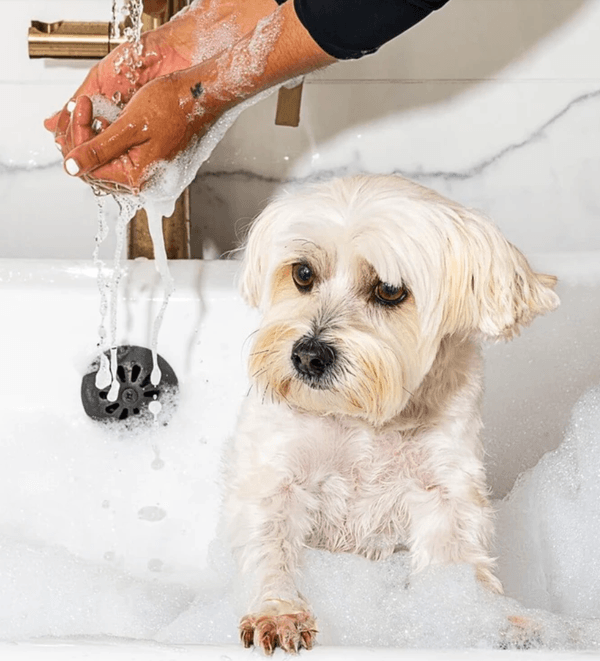
How to Make Bathtime More Enjoyable
Baths can be a strange and uncomfortable experience for pets who aren’t used to bathing. (That’s especially true for cats, most of whom don’t like getting wet!) If you think about it from their perspective, it makes sense — they don’t know what’s happening, they have no control over the situation, and they're wet. Plus, the tub may be slippery, and the shampoo might smell funny.
However, with a bit of practice and consideration of your furry friend’s needs, bath time can be easier and more enjoyable for everyone. Consider the bathing environment from your buddy’s perspective. By putting yourself in their shoes, er, paws, you can find ways to make the experience as comfortable as possible.
The Basics
- Dogs may be bathed inside or outside the home, on a leash or in a fenced yard if outside (only bathe outside if it’s not too cold out). Cats should be bathed inside, so they don’t dart away and get lost if the bath scares them. For baths in the tub or sink, try a bathmat to make the surface less slippery, so your pal feels more comfortable and sure of their footing. Water for bathing should be lukewarm or warm, not cold or too hot.
- Some pets are frightened by the sound of running water, and/or they don’t like being directly under a faucet. You can try a detachable shower head rather than placing your pal directly under the running water, or fill a cup or pitcher with water so you can slowly pour the water over your pet.
- When it comes to their face, use a washcloth rather than pouring water over them, as many pets won’t appreciate water getting into their eyes or ears. Plus, shampoo in the eyes can lead to an eye ulcer, and water in the ears can lead to an ear infection — a washcloth helps you avoid both and gives you more control.
- Use unscented, gentle shampoo designed for pets. Remember, dogs and cats have a stronger sense of smell than we do, and strong scents can be irritating or uncomfortable to them. Aloe and oatmeal-based pet shampoos are gentle enough for most dogs and cats.
- Start gradually and offer praise.
- Don’t plunge your dog or a cat into a tub or douse them with water until you know how they’ll handle the experience. Instead, try introducing them to a dry bathtub first. Offer them praise, or even treats, to make it a good experience. Once they’re comfortable with that, you can try running just a small amount of water over them. When that is going well, increase the amount of water used and start adding a pet shampoo. Keep up the praise and positive reinforcement the whole time in an effort to make the experience as fun and positive as possible.
Post-Bath
You'll want to plan the drying and brushing process. Again, think of it from your pet’s perspective, since they don’t fully understand why these things are being done to them. Try to make it as easy and comfortable as possible for your furry pal.
After the bath, do a thorough towel drying of your buddy. You can make it more enjoyable for them by turning it into a massage or a form of cuddling. Note: Your dog *will* look like ET, and yes, we encourage you to take a photo.
Then, if needed, consider the best way to use additional drying tools. Hair dryers can be too hot and uncomfortable for pets, and the noise may scare them, especially cats. Be sure to use a warm or cool setting, and consider buying one specially made for pets. On the contrary, some pets may enjoy laying in front of a fan until they’re dry, so you’ll want to be sure they’re warm enough, especially during colder months.
When it comes to brushing, many dogs and cats don’t enjoy the feeling of having their hair tugged, especially if they have long hair and tangles. So it's wise to keep up with brushing between baths, so the tangles don’t make bath time particularly unpleasant.
Just like the bathtub, get your pal used to brushing gradually, starting small while offering praise and treats. If severe, tangles and mats in the fur should be removed with hair clippers (not scissors, which run the risk of accidentally cutting the skin) rather than trying to brush them out. If needed, ask your groomer or veterinarian for help with removing thick tangles and matted fur. Brushing them out can be painful — so by avoiding this, bath time will be a better experience for your pet.
As long as your pet isn’t getting into messes and it's more for upkeep, a monthly bath is usually plenty. However, if your pet’s been in pond water or ocean water, give them a bath after each dunk, even if that means you're bathing them every day for a week while on vacation — it’ll prevent bacteria from irritating their skin.
Good luck with bathtime — feel free to send us your ET pics :)